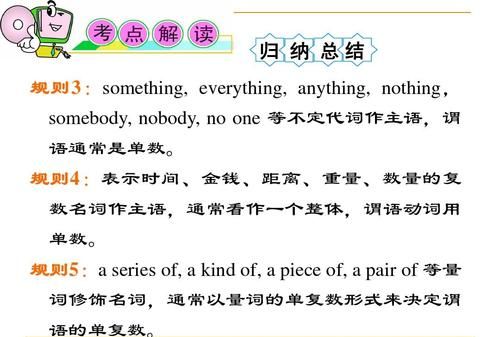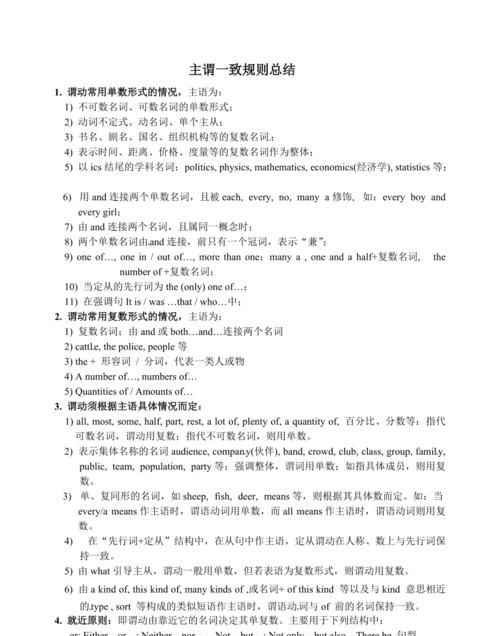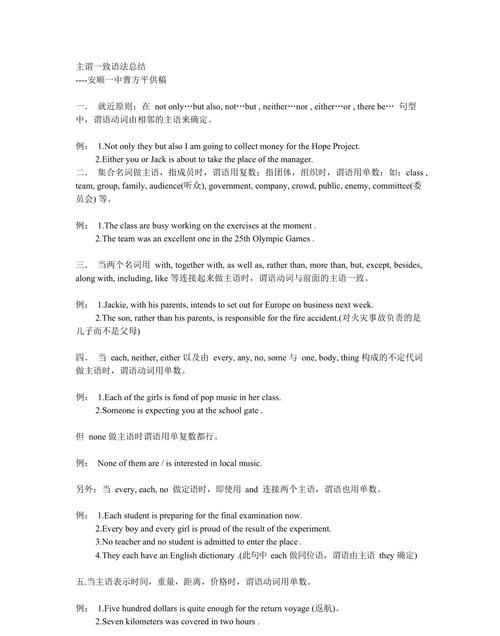本文目录
no修饰的名词谓语动词用单数还是复数
你好。要看语境的:
1 No milk is found in the fridge. -------单数
2 No boy is found in the classroom except two girls -----单数
3 No boys are found in the room except three girls.--------复数

主谓一致语法总结思维导图
前面单数就用单数 后面复数用复数

主谓一致的各种情况及例句英语
一般情况下,主谓之间的一致关系由以下三个原则的支配: 语法一致原则、 意义一致原则和就近原则。
一、语法一致
主谓一致的原则是指主语和谓语从语法形式上取得一致:主语是单数形式,谓语也采取单数形式;主语是复数形式,谓语亦采取复数形式。例如:
He often helps me learn English. (主语是单数形式,谓语也采取单数形式) 。
My friends often help me learn English. (主语是复数形式,谓语也采取复数形式)
但主语和谓语从语法形式上取得一致的问题远不只上述的那么简单,有许多方面的情况需要去具体地对待:
1、不定式,动名词,以及从句作主语时应看作单数,谓语动词用单数。
例如:Reading aloud is helpful to learn English.大声朗读对学习英语是有帮助的。
What he said has been recorded .他说的话已被录音了。
2、不定代词one, every, each, everybody, everyone, one of, no one, nothing, nobody, someone, somebody, either, neither, many a 等作主语或是修饰主语时应看作单数,谓语动词用单数。但none 作主语时,谓语动词既可用单数也可用复数,这要取决于说话人的看法。
例如:Neither of my sisters likes sports .我的妹妹中没人喜欢运动。
Every boy and girl shows great interest in this book .每个男孩和女孩对这本书都表现出很大的兴趣。
3、表示国家,机构,事件,作品等名称的专有名词作主语时应看作单数,谓语动词用单数。
例如:One Thousand And One Nights tells people lots of interesting stories . 《一千零一夜》给人们讲了许多有趣的故事。
4、a kind of, the number of等与名词构成名词短语作主语时应看作单数,谓语动词用单数。
例如:The number of workers in the factory is 400. 这个工厂里工人的数量是400.
A kind of rose in the garden smells very pleasant.这座花园里有一种玫瑰香气怡人。
5、由some, several, both, few, many, a number of 等词修饰主语,或是由它们自身作主语时应看作复数,谓语动词用复数。另外,由and连接两个主语时,谓语一般用复数。
例如:On the seashore, some people are playing volleyball 海边,有些人在打排球。
Both of us are fond of watching football games .我们俩都喜欢看足球赛。
A number of will-be graduates are voluntarily going to work in the West of China. 许多即将毕业的学生打算自愿去中国西部工作。
6、有些表示数量的百分数,分数等后面加名词或代词作主语时,要根据这个名词或代词来决定其谓语动词的单复数形式。如:a lot of, most of, any of, half of, three fifths of, eighty percent of, some of, none of, the rest of , all of等后接不可数名词,或是单数形式的名词作主语时应看作单数,谓语动词用单数;但如果后接可数名词的复数形式作主语时应看作复数,谓语动词用复数。
例如:A lot of money in the shop was stolen yesterday. 昨天那家商店丢失了许多钱。
A lot of students are from England in the school.那个学校里很多学生来自英国。
二、意义一致
这一原则是指,从意义着眼来解决主谓一致问题。有时主语形式上为单数,但意义上却是复数,那么谓语依意义也用复数形式;而有时主语形式上为复数,但意义上却是单数,那么谓语依意义亦用单数形式。
1)当主语后面接由but, except, besides, as well as, as much as, including, more than, no less than, rather than, together with等引导的词组时,其谓语动词的单复数形式通常由前面的词来决定。在这样的句子里,这些词所引导的词组不影响主语自身的单,复数形式,它们在句子里其实是状语。
例如:The teacher, with all his students, is going to have a picnic this weekend.老师打算这个周末与学生们一起去野炊。
The students, together with their teacher, are going to have a picnic this weekend.学生们打算这个周末与他们的老师一起去野炊。
我们完全可以将上面句子中的那些词组都分别搬到句首或是放到句末去,因为它们在句子里是状语:The students are going to have a picnic this weekend together with their teacher.
2)表示时间,金钱,距离,体积,重量,面积,数字等词语作主语时,谓语动词常用单数形式。如:
Eight hours of sleep is enough. 八小时的睡眠足够了。
Twenty years stands for a long period in one's life. 二十年在人的一生里意味着一个很长的时期。
3)形容词前加定冠词即“the + 形容词”作主语时,其意义若是指个人或是抽象概念应看作单数,谓语动词用单数;指一类人则应该看作是复数,那么谓语动词也应该用复数。
例如:The sick here are very well cared for. 这里的病人都被照顾得很好。
The true is to be distinguished from the false. 真实与虚假应加以区别。
4)由and 连接的两个单数名词作主语时,谓语动词一般根据语法一致的原则用复数。
但如果在意义上指同一个人、同一件事或同一个概念时,谓语动词要用单数形式。
如:The writer and teacher is coming. 那位作家兼教师来了。(作家和教师指同一个人)
The writer and the teacher are coming. 作家和老师来了。(作家和老师是两个人)
5)集体名词作主语时,谓语动词的数取决于主语的意义:主语表示整体时视为单数,谓语动词用单数;主语表示集体中的个体成员时视为复数,谓语动词用复数。这类集体名词常见的有:army, class, club, crowd, family, government, group, people, police, public, team等。
例如:The family are all fond of football. 那一家人都喜欢足球。
The family is the tiniest cell of the society. 家庭是社会的最小的细胞。
6)一些形式为复数,意思为单数的名词,如:trousers, pants, shorts, glasses, 等作主语时,谓语动词用复数。
如:Her glasses are new. 她的眼镜是新的。
但当这类名词前有a pair of 修饰时,谓语动词应用单数。
如:This pair of trousers is made in Hangzhou.
三、就近原则
这一原则是指,谓语动词的人称和数常常与最近作主语的词语保持一致。常出现在这类句子中的连词有:or, either… or …, neither… nor … , not only… but also …等。
例如: Either I or they are responsible for the result of the matter. 不是我,就是他们要对那件事的结局负责任。
Neither his family nor he knows anything about it. 他全家人和他都不知道那件事。

英语中主谓一致知识点总结
主谓一致是指:
1) 语法形式上要一致,即单复数形式与谓语要一致。
2) 意义上要一致,即主语意义上的单复数要与谓语的单复数形式一致。
3) 就近原则,即谓语动词的单复形式取决于最靠近它的词语,
一般来说,不可数名词用动词单数,可数名词复数用动词复数。
There is much water in the thermos.
但当不可数名词前有表示数量的复数名词时,谓语动词用复数形式。
e.g. Ten thousand tons of coal were produced last year.
Large quantities of water are needed.
In western countries, mountains of rubbish are thrown away each day.
1 并列结构作主语时谓语用复数
Reading and writing are very important.
注意: 当主语由and连结时,如果它表示一个单一的概念,即指同一人或同一物时,谓语动词用单数,and 此时连接的两个词前只有一个冠词。
The iron and steel industry is very important to our life.
典型例题
The League secretary and monitor ___ asked to make a speech at the meeting.
A. is B. was C. are D. were
答案B. 注: 先从时态上考虑。这是过去发生的事情应用过去时,先排除A.,C.。本题易误选D,因为The League secretary and monitor 好像是两个人,但仔细辨别, monitor 前没有the,在英语中,当一人兼数职时只在第一个职务前加定冠词。后面的职务用and 相连。这样本题主语为一个人,所以应选B。
2 主谓一致中的就近原则
1) 当there be 句型的主语是一系列事物时,谓语应与最邻近的主语保持一致。
There is a pen, a knife and several books on the desk..
There are twenty boy-students and twenty-three girl-students in the class.
2)当either… or… 与neither… nor, 连接两个主语时,谓语动词与最邻近的主语保持一致。 如果句子是由here, there引导,而主语又不止一个时,谓语通常也和最邻近的主语一致。 Either you or she is to go.
Here is a pen, a few envelopes and some paper for you.
3 谓语动词与前面的主语一致
当主语后面跟有with, together with, like, except, but, no less than, as well as 等词引起的短语时,谓语动词与前面的主语一致。
The teacher together with some students is visiting the factory.
He as well as I wants to go boating.
4 谓语需用单数
1) 代词each和由every, some, no, any等构成的复合代词作主语,或主语中含有each, every, 谓语需用单数。
Each of us has a tape-recorder.
There is something wrong with my watch.
2) 当主语是一本书或一条格言时,谓语动词常用单数。
The Arabian Night is a book known to lovers of English.
《天方夜谭》是英语爱好者熟悉的一本好书。
3) 表示金钱,时间,价格或度量衡的复合名词作主语 时,通常把这些名词看作一个整体,谓语一般用单数。(用复数也可,意思不变)。
Three weeks was allowed for making the necessary preparations.
Ten yuan is enough.
5 指代意义决定谓语的单复数
1) 在代词what, which, who, none, some, any, more, most, all等词的单复数由其指代的词的单复数决定。
All is right. (一切顺利。)
All are present. (所有人都到齐了。)
2) 集体名词作主语时,谓语的数要根据主语的意思来决定。如family, audience, crew, crowd, class, company, committee等词后用复数形式时,意为这个集体中的各个成员,用单数时表示该个集体。
His family isn't very large. 他家不是一个大家庭。
His family are music lovers. 他的家人都是音乐爱好者。
但集合名词people, police, cattle, poultry等在任何情况下都用复数形式。
Are there any police around?
3)有些名词,如variety, number, population, proportion, majority 等有时看作单数,有时看作复数。
A number of +名词复数+复数动词。
The number of +名词复数+单数动词。
A number of books have lent out.
The majority of the students like English.
population的谓语动词形式与表语一致,一般来说与分数,百分数连用时,谓语动词用复数。
6 与后接名词或代词保持一致
1) 用half of, part of, most of, a portion of 等词引起主语时,动词通常与of后面的名词,代词保持一致。
Most of his money is spent on books.
Most of the students are taking an active part in sports.
2) 在一些短语,如 many a 或 more than one 所修饰的词作主语时,谓语动词多用单数形式。但由more than… of 作主语时,动词应与其后的名词或代词保持一致。
Many a person has read the novel. 许多人都读过这本书。
More than 60 percent of the students are from the city.百分之六十多的学生都来自这个城市
求采纳为满意回答。

以上就是关于no主谓一致的用法 ,no修饰的名词谓语动词用单数还是复数的全部内容,以及no主谓一致的用法 的相关内容,希望能够帮到您。

